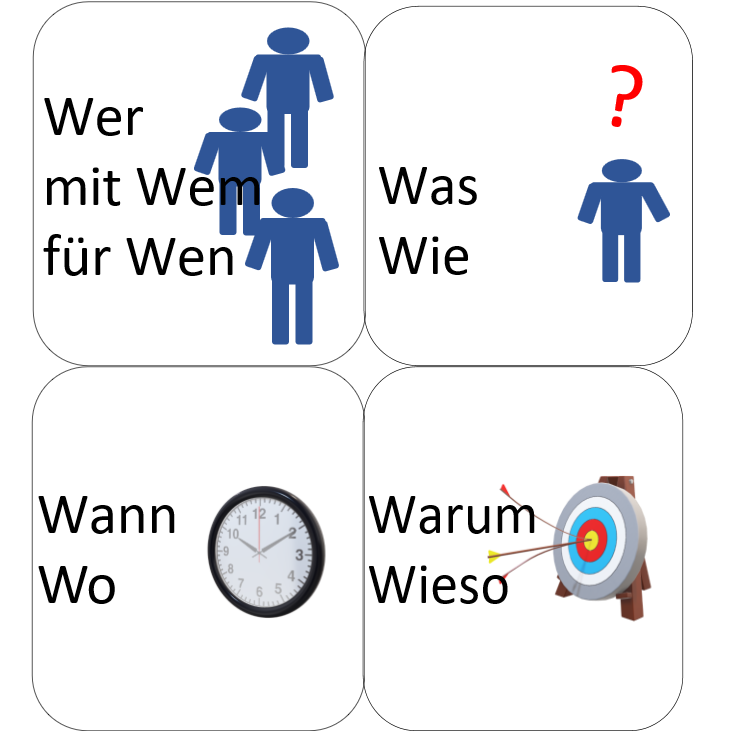The Question Square
Plan seminars efficiently with the question square

There are many things to consider when planning a new seminar. The question square helps to create structure and to think about all important questions. By using the question square, the trainer is forced to go into more detail.

Who With Whom For Whom?
In the first quadrant (quarter) of the question square you answer all questions that have to do with people. The following questions fall into this category:
- Who holds the seminar?
- Should the seminar be conducted by several trainers?
- Can the seminar be held alone or is a partner required (e.g. for certain sub-topics)?
- Who can represent me in case of doubt?
- Which target group should be addressed?
The trainer should think in advance whether he wants to and can hold the seminar / training alone or whether he gets (a) partner to do so. This decision depends on various factors:
- Topic
- Scope of the seminar
- Number of participants
- ...
There are pros and cons to conducting a seminar with multiple trainers.
Advantages:
- Seminar group can be divided if necessary
- Less workload per trainer
- Opportunity for more intensive individual coaching (this would be a great advantage, especially for more introverted participants)
Disadvantages:
- Organizational overhead
- If necessary, compromises in the seminar design
In any case, it is advisable to have a representative who can step in and lead the seminar in an emergency. Canceling planned appointments at short notice is usually unnecessary and does not make a good impression on customers.
What? How?
The second quadrant is about defining the topic and the methods used:
- What is to be taught?
- Which methods should be used?
- What are the (individual) learning objectives?
- In which taxonomy levels should the individual (sub-)topics be taught?
The topic is of essential importance for every seminar. Once the trainer has decided on a topic, it is time to consider which specific content and sub-topics are particularly relevant. He can determine this using various creative techniques (a mind map is particularly useful here, since the topics are already pre-grouped).
The next step is to analyze how the individual subtopics (teaches) can be conveyed in such a way that the participants achieve the best possible learning success. There are various learning methods that a seminar leader can integrate into the training. These are, for example, various games, smaller group work, role-playing games, etc. It is important that these are specifically incorporated into the course of the seminar.
When? Where?
In the third quadrant, organizational questions are answered:
- When does the seminar take place?
- Where does the seminar take place?
- How long does the seminar last?
- What are the start and end times?
- When are breaks taken?
- What requirements does the seminar location have to meet?
- What equipment / equipment is required?
- How much space is required?
- How should tables and chairs be arranged?
- Is there a place to buy food nearby?
- What is the public transport infrastructure like?
- ...
The seminar leader should think carefully about the place and time of the seminar. When will the training take place, how many days will it last and how should the seminar room be set up? When setting up the seminar room, make sure that there is enough space for all participants and the trainer's equipment. Also to consider is the environment. The participants should have the opportunity to get something to eat during the lunch break. The transport connection to the venue should also be taken into account.
Why?
The fourth and last quadrant determines the motivation with which potential participants will attend the seminar. The following questions are taken into account:
- What problems does the seminar solve?
- What are the goals of the seminar?
- What benefits do participants get from attending the seminar?
- What needs of the participants are met?
When planning the seminar, the trainer should deal with the question of which problems he would like to solve for the participants and how he can remedy them. He should also be aware of the goals the participants should achieve by attending the seminar.
The SMART formula can help the trainer to set goals for the seminar. This can be used to define, plan and implement goals in detail. The set goals must be achievable for all participants.
Conclusion
The conscientious elaboration of the question square means that the trainer has already created the complete outer framework of the seminar. Now the concrete substantive elaborations (e.g. in the form of a trainer guide) can take place.